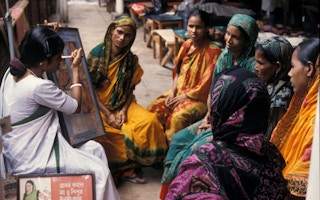In 2012, the London Declaration on Neglected Tropical Diseases signaled a bold new vision for international cooperation, in which networking and globalization could underpin efforts in the global South to eradicate deadly diseases that disproportionately affect the poorest communities.
The London Declaration – the largest global public-health collaboration to date – helped to foster trust in the rules-based global order that emerged after World War II.
But this hard-earned trust is now in grave danger as populist forces across the Western world take aim at their countries’ foreign-aid commitments. In particular, President Donald Trump has announced sweeping cuts to the United States’ international aid budget, in order to appease economically frustrated US voters who want their tax money spent at home.
What this approach fails to recognize is that the long-term rewards of supporting medical research in the global South far outweigh the short-term costs.
As a Bangladeshi researcher at the International Centre for Diarrhoeal Disease Research, Bangladesh (icddr,b), I have been intimately involved in local efforts to eradicate visceral leishmaniasis (VL, also known as kala-azar), one of the diseases covered by the London Declaration. Thanks to generous support from international donors, I have been able to conduct path-breaking research in the field.
Back in 2006, through research funded by the World Health Organization’s Special Programme for Research and Training in Tropical Diseases (TDR), I found virtually no sandfly-control initiatives in place in districts where VL – spread by a single species of sandfly – was endemic. That realization was a wake-up call to policymakers and led to the initiation of sandfly-control efforts throughout the country.
Years later, as part of UBS Optimus Foundation-funded research into household-level insect-control methods, my team found that a novel technology – durable wall linings soaked with the insecticide deltamethrin – was effective at killing sandflies for up to a year after application. We are currently testing other durable insect-control solutions, including wall paints blended with three different insecticides.
This work has implications beyond VL – and beyond Bangladesh. Indoor spraying remains the most widely used method of household insect control worldwide. But in isolated rural communities, the solutions that we are researching may be more robust, convenient, and effective against not just sandflies, but also other kinds of disease-carrying insects, such as Zika-infected mosquitos.
I have also been engaged in research on novel types of VL transmission. After recovering from VL, many patients in Bangladesh go on to develop a condition known as macular post-kala-azar dermal leishmaniasis. In order to find out whether PKDL patients can act as a reservoir for VL – and therefore boost our capacity to eradicate the disease – my team and I have set up an insectarium to breed sterile sandflies.
“
But this hard-earned trust is now in grave danger as populist forces across the Western world take aim at their countries’ foreign-aid commitments.
Our insectarium – funded by the Drugs for Neglected Diseases Initiative and the Spanish Foundation for International Cooperation – is one of just seven in the world (with the majority located in developed countries). It amounts to a permanent and valuable resource for research into vector control and disease transmission in Bangladesh.
Already, the insectarium has facilitated important progress. Recent pilot experiments showed that macular PKDL can act as a source of infection, with the results published in the journal Clinical Infectious Diseases. We are also using the insectarium to test insecticide resistance and susceptibility in captive sandflies – research that will support the optimization of sandfly-control strategies throughout the Indian subcontinent.
Of course, a key element of any strategy to eradicate disease is early and effective diagnosis. When it comes to VL, standard diagnoses rely on the detection of circulating antibodies in blood or urine. But, because antibodies persist in the blood even after recovery, this method falsely identifies healthy, non-contagious patients as needing treatment.
While a DNA-based diagnostic test provides more accurate results, the methods currently used rely on expensive equipment like thermal cyclers and functioning cold chains.
So my team went to work to develop a system for enabling DNA-based diagnosis in low-resource settings. Using an isothermal DNA amplification method, called recombinase polymerase amplification, we developed a cold-chain-independent method for detecting VL, which we then incorporated into a solar-powered mobile “lab suitcase” that can be used easily in rural settings.
We are now trying to repurpose that suitcase, so that it can also enable the diagnosis of typhoid fever and tuberculosis, further revolutionizing disease surveillance in poor and rural communities. In other words, the development of cold-chain-independent disease detection, like the rest of our research and innovations, has far-reaching implications for global health.
Yet all of the success we have achieved over the last two decades is now at risk. Donor agencies, facing reduced aid from major players like the US, could be forced to withdraw funding for the kind of research described here.
With Bangladesh unable to pick up the slack, life-saving projects like ours will collapse; the long-term resources we have developed, from the insectarium to new diagnostic devices, will have to be abandoned; and the developing world’s poorest communities will suffer.
More is at stake than generosity. Aid donors accrue important benefits from financing scientific research in the global South, beginning with reinforcement of the trust that underpins the fragile international order on which we all depend.
More directly, supporting the development of low-cost health innovations could play a vital role in reducing the now-colossal health-care expenditure of advanced countries like the US. Those savings could, in the long term, easily offset the cost of supporting the life-saving work of organizations like icddr,b.
Dinesh Mondal is a senior scientist in the Nutrition and Infection Interaction Research Unit at icddr,b.
© Project Syndicate 1995–2017


















